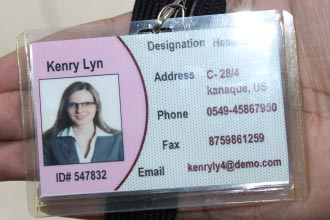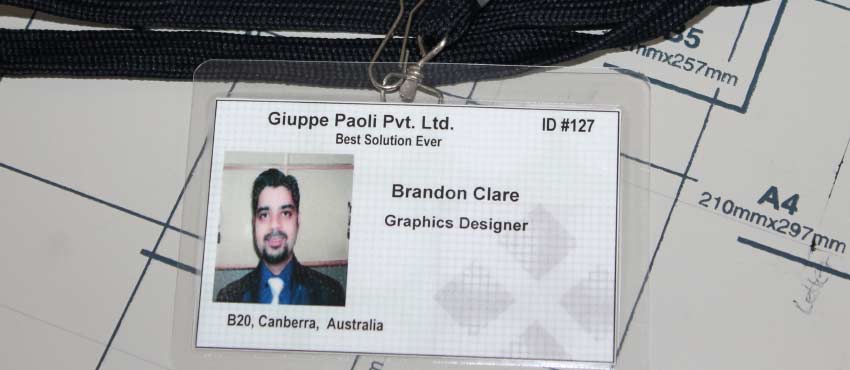An ID badge, also known as an identification badge or identity card, is a small card or tag that is typically worn or carried by individuals to provide visual identification and verification of their identity. It serves as a means of identifying the cardholder and can contain various information related to their role, organization, or access privileges.

Posted By: Tech Solution | Last Updated On:
Some Detailed Aspects of an ID Badge
⬗ Identification: The primary purpose of an ID badge is to provide visual identification of the person carrying it. It helps others easily identify the individual and verify their identity.
⬗ Security: ID badges play a crucial role in enhancing security within organizations, institutions, or events. By clearly displaying the name and photo of the cardholder, it helps prevent unauthorized individuals from gaining access to restricted areas or sensitive information.
⬗ Access Control: Many ID badges incorporate security features such as barcodes, magnetic stripes, or embedded chips to grant or restrict access to specific areas or systems. These features allow for efficient access control and can be used in conjunction with access control systems.
⬗ Branding and Representation: ID badges often display the logo, name, or slogan of the organization the individual represents. They serve as a form of branding and can contribute to a professional image for the organization.
⬗ Cardholder's Name: The ID badge typically includes the name of the individual, which can be printed prominently for easy identification.
⬗ Photograph: A clear photograph of the cardholder is commonly included on the ID badge to provide visual verification of their identity.
⬗ Title or Role: The cardholder's job title or role within the organization is often mentioned on the ID badge to provide additional information about their responsibilities or authority.
⬗ Organization Name and Logo: The name, logo, or emblem of the organization or institution the cardholder belongs to is usually displayed on the ID badge for branding purposes.
⬗ Unique Identifier: Some ID badges include a unique identifier such as an employee or member ID number, barcode, QR code, or magnetic stripe. These identifiers can be scanned or read electronically to link the cardholder's information with databases or access control systems.
⬗ Expiration Date: In certain cases, ID badges may have an expiration date to ensure regular renewal and continued validity.

- Design Customization: ID badges can be customized to reflect the organization's branding or design preferences. This can include choosing colors, fonts, background images, or other visual elements.
- Security Features: To prevent counterfeiting or tampering, ID badges may incorporate various security features such as holograms, UV printing, microprinting, or watermarks. These features enhance the authenticity and integrity of the ID badge.
- Technology Integration: Some ID badges utilize advanced technologies like smart cards or RFID (Radio-Frequency Identification) chips to store additional information or enable contactless access control.
Lanyards: ID badges are often worn around the neck using lanyards or retractable badge reels. This allows for easy visibility and quick presentation of the ID when required.
Badge Holders: Clear plastic badge holders are commonly used to protect the ID badge from wear and tear. They provide a secure and visible display of the ID badge and may include additional features like clips or pins for attachment.
Badge Clips or Pins: Alternatively, ID badges can be attached directly to clothing using badge clips or pins.
Conclusion: ID badges serve as a visual representation of an individual's identity and affiliation with an organization or institution. They play a vital role in ensuring security, access control, and proper identification within various settings. The design and features of ID badges can vary depending on the specific needs and requirements of different organizations.
Some Detailed Benefits of using ID Badges
ID badges, also known as identification badges or access cards, offer numerous benefits across various contexts. Here are some detailed benefits of using ID badges:
-
Enhanced Security:
ID badges contribute significantly to improving security within organizations and facilities. By clearly displaying an individual's name, photograph, and relevant information, ID badges help identify authorized personnel, distinguishing them from unauthorized individuals. This visual verification assists security personnel in quickly identifying individuals who may pose a threat, enhancing overall security measures.
-
Access Control:
Many organizations utilize ID badges with embedded technology, such as magnetic stripes, smart chips, or proximity cards. These technologies enable access control systems that restrict entry to specific areas, ensuring only authorized personnel can enter. Access control systems enhance physical security by preventing unauthorized individuals from accessing sensitive areas or valuable assets.
-
Identity Verification:
ID badges serve as a reliable means to verify a person's identity. By displaying a photograph, name, and other identifying details, ID badges make it easier to confirm if someone is who they claim to be. This is particularly crucial in situations where individuals interact with customers, clients, or patients, as it instills confidence and trust in the authenticity of the staff members.
-
Employee Accountability:
ID badges contribute to maintaining accountability within organizations. By wearing visible identification, employees are more likely to adhere to policies and rules, as they are aware that their actions can be traced back to them. In situations where specific privileges or clearances are assigned, ID badges help track an individual's activities and monitor their access to sensitive areas or resources.
-
Efficient Communication:
ID badges often include essential information such as job titles, departments, and contact details. This promotes effective communication among employees, allowing them to quickly identify colleagues and establish direct lines of communication. ID badges can facilitate teamwork, collaboration, and seamless interactions within the workplace.
-
Brand Representation:
In corporate settings, ID badges can be customized to include a company logo or branding elements. This helps promote brand visibility and recognition both internally and externally. Employees wearing ID badges that represent the organization contribute to a professional and cohesive image, strengthening the company's brand identity.
-
Emergency Response:
During emergencies or evacuations, ID badges assist in accounting for personnel and ensuring everyone's safety. Emergency response teams can easily identify and verify employees who may require assistance or evacuation. ID badges can also provide access to emergency contact information, medical conditions, or special needs, enabling appropriate and timely responses in critical situations.
-
Streamlined Processes:
In large organizations, ID badges often incorporate barcodes or QR codes that can be scanned for various purposes. These codes can be linked to employee records, enabling streamlined processes such as timekeeping, attendance tracking, visitor management, or equipment loans. By automating these processes, ID badges save time and reduce administrative burdens.
-
Regulatory Compliance:
In certain industries, regulatory standards require the use of ID badges to comply with specific security and safety regulations. For instance, healthcare facilities may need to ensure that healthcare providers visibly display their identification for patient safety and privacy purposes. Using ID badges helps organizations meet these regulatory requirements and avoid potential penalties.
Conclusion: Overall, ID badges offer a range of benefits, including enhanced security, access control, identity verification, employee accountability, efficient communication, brand representation, emergency response capabilities, streamlined processes, and regulatory compliance. Implementing a robust ID badge system can contribute to a safer, more organized, and productive environment.
Importance of ID Badge Design
ID badge design plays a crucial role in effectively serving its intended purposes and maximizing the benefits mentioned earlier. Here's a detailed explanation of the importance of ID badge design:

-
Visual Recognition:
The design of an ID badge should prioritize clear and easily recognizable visual elements. A well-designed badge will prominently display the individual's photograph, name, and other identifying information, ensuring quick and accurate visual recognition. This helps security personnel, employees, and other stakeholders easily identify authorized personnel and distinguish them from unauthorized individuals.
-
Professional Image:
ID badges are representative of an organization's brand and professionalism. A thoughtfully designed badge reflects the company's image and values, contributing to a professional and cohesive appearance. A visually appealing badge design helps create a positive first impression on clients, customers, and visitors, instilling confidence and trust in the organization and its employees.
-
Brand Consistency:
ID badge design should align with the organization's branding guidelines to maintain brand consistency. By incorporating the company logo, color scheme, and typography, the badge reinforces the organization's visual identity. Consistent branding across ID badges contributes to a unified and professional image, both internally and externally.
-
Readability and Legibility:
The design of an ID badge should prioritize readability and legibility of the information displayed. This includes using clear and legible fonts, appropriate font sizes, and contrasting colors to ensure easy reading. Proper spacing and organization of information on the badge make it more user-friendly and accessible for quick identification and verification.
-
Durability and Quality:
ID badges are typically used on a daily basis and subjected to various environmental conditions. The design should consider the durability and quality of the badge materials. A well-designed badge ensures longevity, resistance to wear and tear, and maintains its visual appeal even after prolonged use. This prevents the need for frequent badge replacements, reducing costs and ensuring consistent identification.
-
Customization and
Differentiation:
Depending on the organization's needs, ID badges can be customized to differentiate between different personnel levels, departments, or access levels. Design elements such as color-coding, icons, or additional visual indicators can be incorporated to distinguish different groups or roles. Customization allows for efficient identification and can contribute to better organization and security management within the workplace.
-
Compliance with Standards:
In some industries or organizations, specific design standards and regulations govern ID badges. For example, healthcare facilities may require specific badge designs to comply with patient privacy regulations. Adhering to these standards ensures that the ID badges meet legal and industry requirements, avoiding potential penalties or security vulnerabilities.
-
User-Friendly Features:
The design of ID badges can incorporate user-friendly features to enhance functionality. For example, including a barcode or QR code can enable quick scanning for access control, attendance tracking, or other automated processes. Such features improve efficiency, streamline operations, and reduce manual errors.
-
Wearability and Comfort:
ID badge design should also consider the practicality and comfort of wearing the badge throughout the day. Factors such as size, weight, attachment mechanisms, and ergonomic considerations should be taken into account. A well-designed badge ensures that it can be easily worn without causing discomfort or hindering daily tasks.
Conclusion: ID badge design is essential for ensuring visual recognition, portraying a professional image, maintaining brand consistency, enhancing readability, ensuring durability, allowing customization, complying with standards, incorporating user-friendly features, and considering wearability and comfort. By paying attention to these design elements, organizations can maximize the effectiveness and usability of ID badges in various contexts.